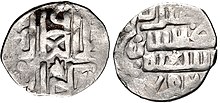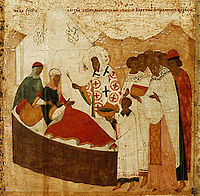|
Jani Beg
Jani Beg (Persian: جانی بیگ, Turki/Kypchak: جانی بک; died 1357), also known as Janibek Khan, was Khan of the Golden Horde from 1342 until his death in 1357. He succeeded his father Öz Beg Khan. ReignWith the support of his mother Taydula Khatun, Jani Beg made himself khan after eliminating his older brother and rival Tini Beg at Saray-Jük in 1342; he had already killed another ambitious brother, Khiḍr Beg. He is known to have actively interfered in the affairs of the Russian principalities and of Lithuania.[1] The grand princes of Moscow, Simeon and Ivan II, were under constant political and military pressure from Jani Beg. Jani Beg commanded a massive Crimean Tatar force that attacked the Crimean port city of Kaffa, then a Genoese colony, in 1343. The siege was lifted by an Italian relief force in February. In 1345, Jani Beg again besieged Kaffa; however, his assault was again unsuccessful due to an outbreak of plague among his troops. Jani Beg's army catapulted infected corpses into Kaffa in an attempt to use the plague to weaken the defenders. Infected Genoese sailors subsequently sailed from Kaffa to Genoa, Messina, and Constantinople, introducing the Black Death into Europe.[2] The story involving the catapult has been disputed. It is originally based on Gabriel de Mussis of Piacenza in Italy, who wrote about the plague in 1348. It is more likely that rats carrying plague-infested fleas went from the Jani Beg's camp to the city and thereby infected the Genoese.[3][4]  In 1356, Jani Beg conquered the city of Tabriz, installing his own governor. He also asserted Jochid dominance over the Chagatai Khanate, attempting to unite the three khanates of the Mongol Empire. After accepting surrender from Shaikh Uvais, Jani Beg boasted that three ulus (districts/nations) of the Mongol Empire were under his control. Soon after this, he faced an uprising in Tabriz resulting in the rise to power of the Jalayirid dynasty, an offshoot of Ilkhanate, and ultimately in the death of the Khan. The Chudov Monastery in Moscow, founded at about the time of Jani Beg's fall by Metropolitan Aleksii and Sergii of Radonezh, was built on land that according to legend was granted to Aleksii by the Khan as thanks for the miraculous curing of his mother Taydula by the former.[citation needed] The reign of Jani Beg was marked by the first signs of the feudal strife which would eventually contribute to the demise of the Golden Horde. Jani Beg's assassination in 1357 opened a quarter-century of political turmoil within the Golden Horde. Twenty-five khans took power between 1357 and 1378.
Catalan Atlas (1375) Jani Beg appears in the 1375 Catalan Atlas: the Mongol polity of the Golden Horde is accurately depicted north of the Caspian Sea. Jani Beg has been identified in this representation, being mentioned as "Jambech senyor de Sarra", and the flag of the Golden Horde also appears (
The symbolism of the Golden Horde flag depicted by the Catalan Atlas ( Family  Jani Beg had a number of sons, only one of whom, Berdi Beg, reigned after him but who proceeded to eliminate his brothers. Two or three more khans appear to have claimed to be Jani Beg's sons and are sometimes treated as such by modern scholars.[11]
Genealogy
In popular cultureThe 2012 Russian film The Horde is set during the reign of Jani Beg and is a highly fictionalised narrative of how Aleksii healed Taidula from blindness.[citation needed] See alsoReferences
Bibliography
|
||||||||||||||||||||||||||||||




